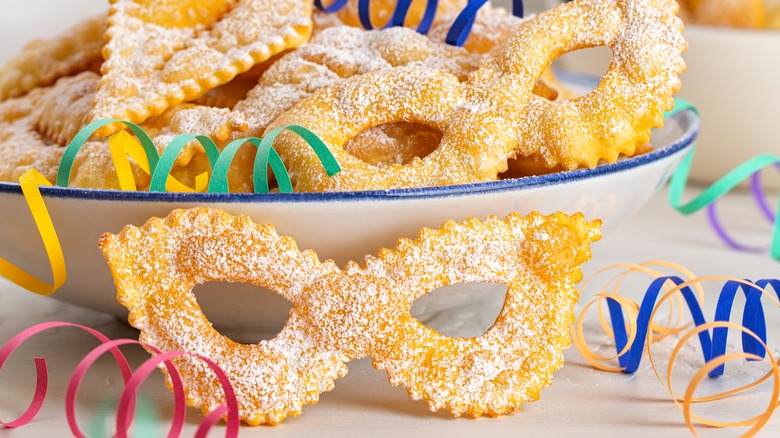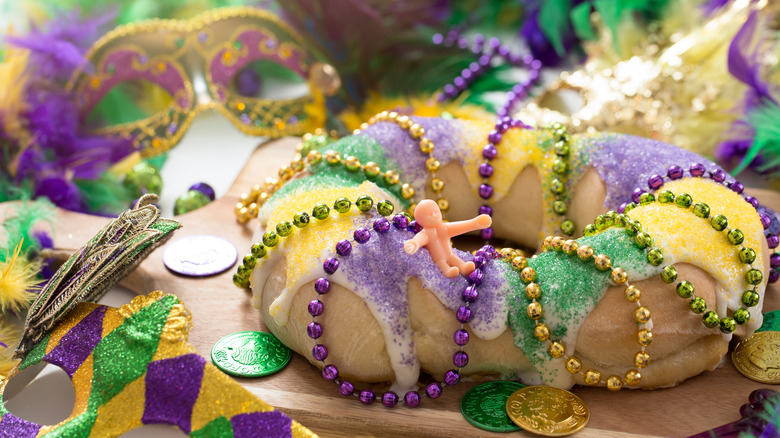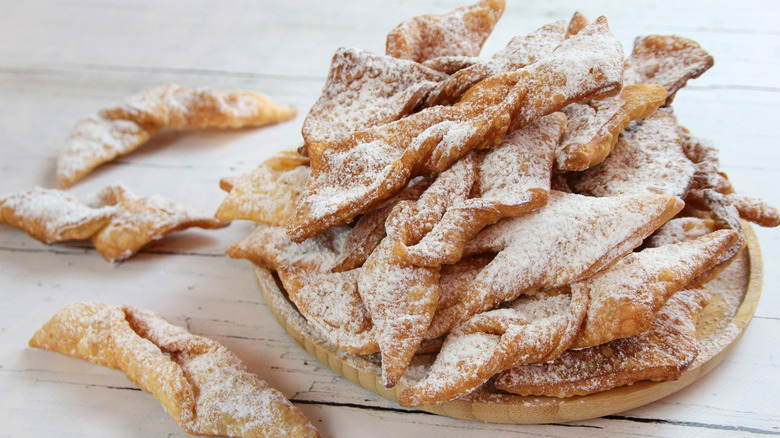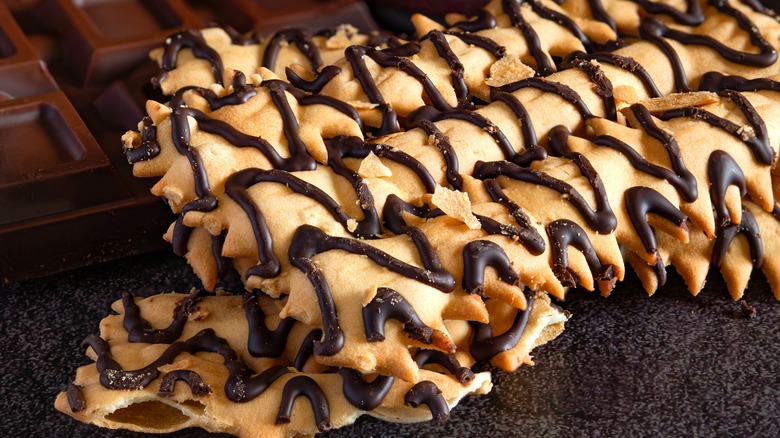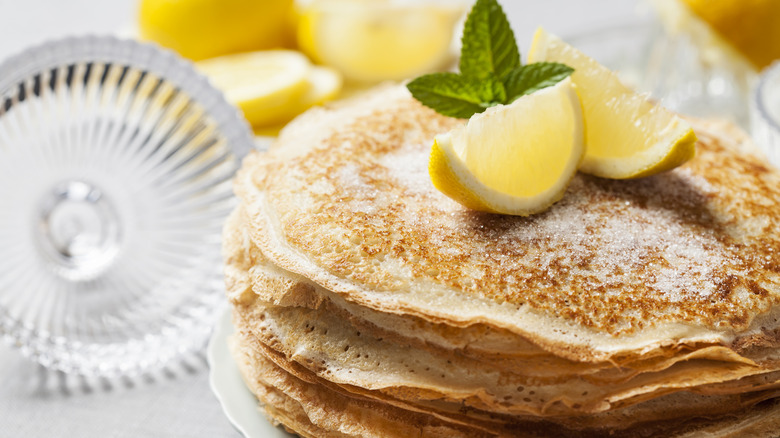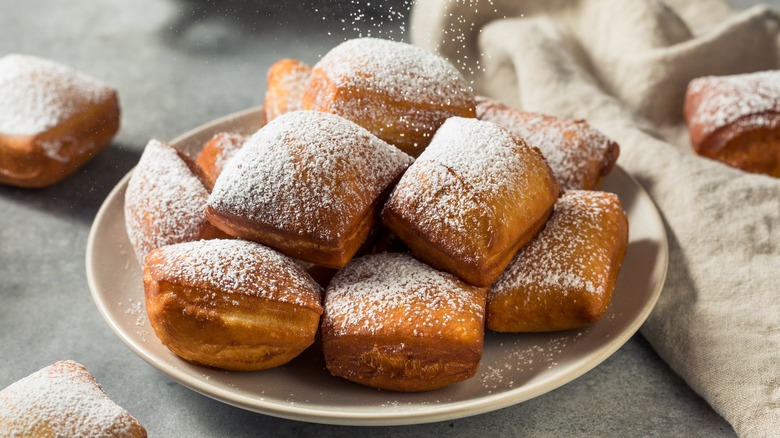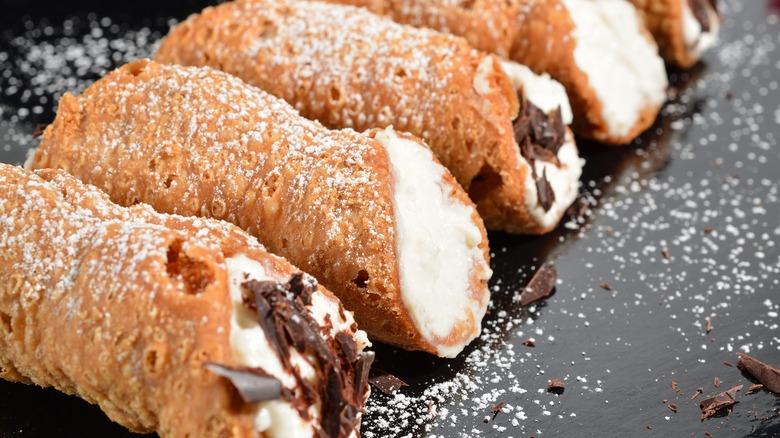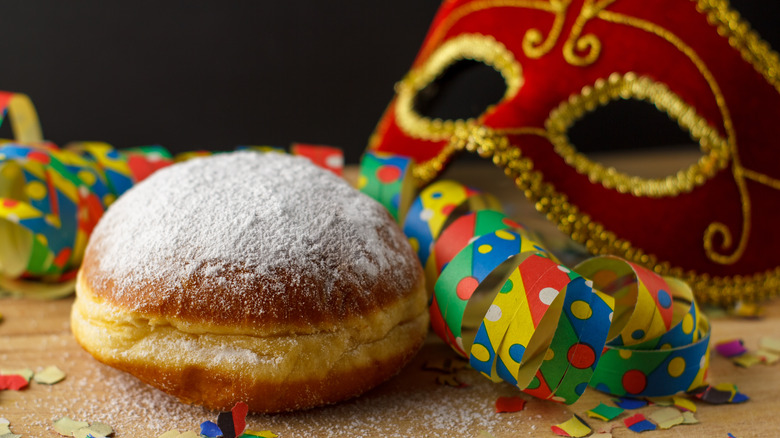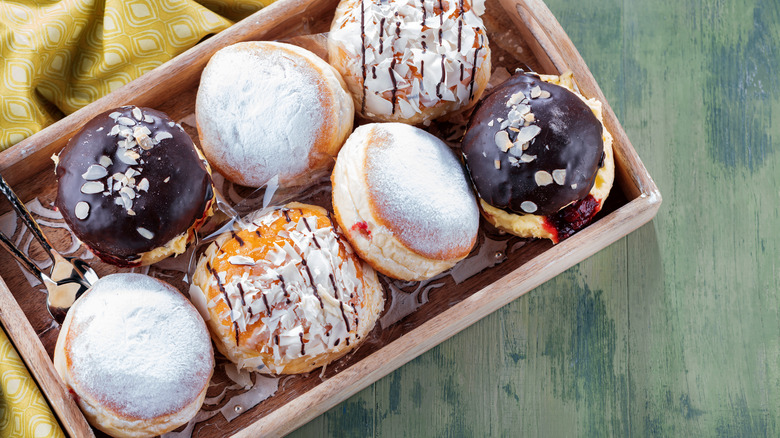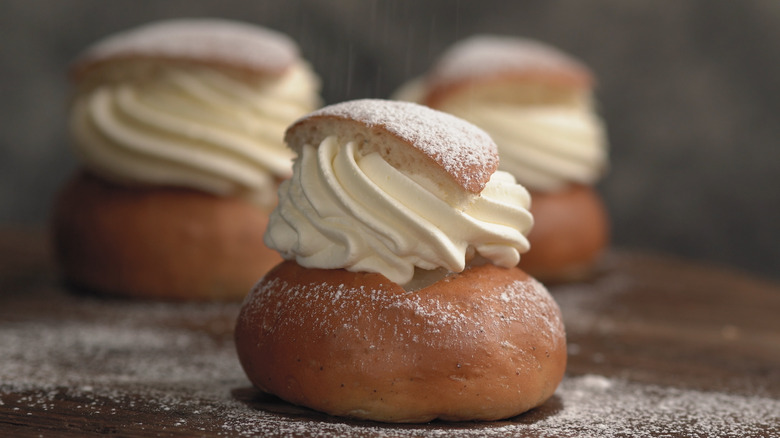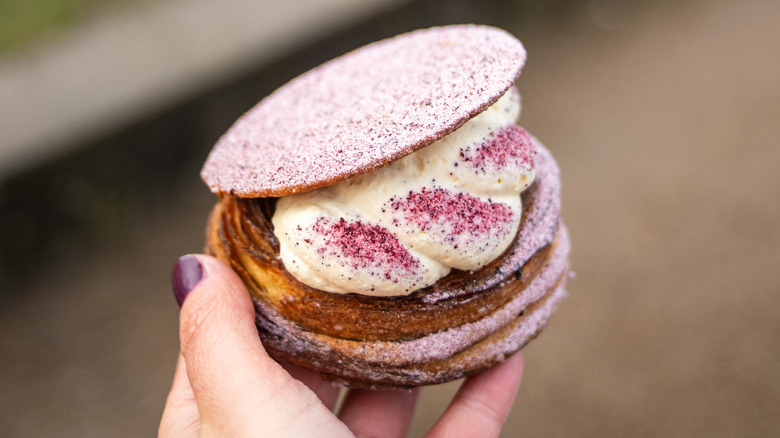Mardi Gras Pastries From Around The World
For Western churches, Lent is a time of abstinence and simplicity, when people practice deprivation and self-control. It begins on Ash Wednesday, 40 days before Easter. The preceding day, called Shrove Tuesday, has over the centuries grown into a festival, a last hurrah before the fasting of Lent. As such, it has accumulated various nicknames in different cultures across the globe.
Perhaps the most popular moniker in the U.S. is Mardi Gras, or Fat Tuesday in French, made famous by the city of New Orleans, Louisiana. The occasion is celebrated with massive parades, parties, and feasting. In many English-speaking countries, it is known as Pancake Day. For others it is Paczki Day. Shrove Tuesday also marks the end of the Carnival season in those regions that celebrate.
Whatever you call it, nearly every one of these celebrations has one thing in common: pastries. Because eggs, sugar, and fat are not allowed during the fasting of Lent, these foods were used up on the last day so as not to go to waste in the 40 days leading up to Easter. That is, admittedly, less of a concern in the days of refrigeration, but who doesn't love a good doughnut?
Read on to learn how different cultures around the world use up their forbidden foods. Maybe you will find inspiration to liven up your own celebrations. As they say in the Big Easy, laissez les bons temps rouler (let the good times roll)!
King cake
Speaking of New Orleans, if you visit for Mardi Gras, you might notice a brightly decorated round or oval cake for sale at grocery stores and local bakeries. These are called king cakes, and the green, yellow, and purple are the signature colors of Mardi Gras.
As explained by Today, king cake season starts on Epiphany (January 6) and ends on Mardi Gras. King cakes come in different forms around the world. France has galettes des rois, and Spanish-speaking countries have the rosca de reyes. But the New Orleans' version seems particularly iconic given its vibrant colors. It is a brioche-like pastry that is braided and has cinnamon and cream cheese mixed in. The two ends of the braided pastry are then joined to make a ring shape. The baked cake is then topped with icing and colorful sprinkles.
What all of the king cakes, French and Spanish, have in common is a hidden item. For New Orleans, it's a little plastic baby that many say represents baby Jesus. In France, a bean is often used. Whoever finds the hidden item in their slice of cake is crowned king for the day. A local New Orleans custom states that the lucky winner also has to provide the king cake for the next party.
Paczki
For communities in the U.S. with high numbers of Polish immigrants and their descendants, the day before Ash Wednesday is Paczki Day (pronounced POONCH-key). The city of Hamtramck, Michigan, explained that in Poland, people actually celebrate Paczki Day on Fat Thursday, the last Thursday before Lent begins, but Tuesday is more common in the U.S. due to the popularity of Mardi Gras. Fat Tuesday is also when Hamtramck holds its annual Paczki Day Parade.
According to Polish news site NaTemat, the oldest recipe book in Poland dates back to 1682 and contains a recipe for paczki. Often translated as "doughnut," paczki are stuffed pastries fried in oil. The recipe from 1682 calls for jam made from damask rose petals, though just about any kind of filling goes these days, from fruit preserves to Bavarian cream.
Paczki resemble jelly doughnuts, but the dough is different from what people in the U.S. typically consume. A pair of nuns explained their process on Catholic Online. Eggs are mixed with flour and sugar, then the dough is allowed to rise in a heated kitchen. The dough is then kneaded, formed into balls, and stuffed with the fillings of choice. Vodka is used on the dough to prevent it from soaking up too much oil.
Once the paczki are cooked, they are often covered in icing, sprinkled with powdered sugar, or decorated with fried orange zest (per Hamtramck).
Angel wings
According to The Spokesman-Review, paczki are not the only tasty treat you will find in Poland around Lent. Also known as faworki, chrusty, and chrusciki in Polish, these pastries are called angel wings in English. Many European countries make similar cookies. The main ingredients are eggs, sugar, and flour, and beyond that, ingredients vary according to the cook. Like paczki, they are fried in oil. The crispy cookies are then dusted in powdered sugar.
Polish news site Onet said that the cookies are often long and skinny, shaped sort of like a bow tie, but other shapes do occasionally pop up, like that of a rose. It's unclear where the name angel wings comes from. Perhaps the "wings" of the bow were once thought to resemble the wings of an angel?
Polish Language Blog shared where these cookies may have come from and why they are linked with paczki in the lead-up to Lent. One day while making paczki, a baker tossed a strip of leftover dough into the fryer. He didn't shape it first, however. The dough twisted itself into its now iconic shape. The baker scooped it out, dusted it in powdered sugar, and enjoyed the result. Now these desserts are a beloved part of the Polish carnival season.
Chatters with blood pudding
In Naples, Italy, you will find a cookie very similar to Poland's angel wings called chiacchiere, or chatters. Visit Naples explained they are also thin cookies with few ingredients that are sometimes folded into a bow shape or left as long, thin strips. After being baked or fried to a crisp, they are dusted in powdered sugar, though, as with angel wings, variations exist.
What makes chatters so unique is that they are often paired with sanguinaccio dolce, or blood pudding. According to Atlas Obscura, when Italian butchers historically killed their pigs, they would collect the blood and mix it with milk, sugar, and chocolate and heated on the stovetop to create a creamy pudding. Culinary Backstreets described the aftertaste of this original pudding as acidic. Chatters, or sometimes ladyfingers, are dipped into the pudding.
But if blood makes you squeamish, you don't have to worry about this dish. Due to the risk of pigs' blood going bad so easily, its sale was banned across Italy in 1992. Nowadays, unless you are at a farm that butchers its own pigs, the pudding is made with only the bittersweet chocolate. Even without the blood, the name remains the same. And, of course, you can enjoy the crispy, sweet chatters all on their own.
Pancakes
As we mentioned earlier, many parts of the English-speaking world celebrate Pancake Day or, per Irish Culture and Customs, Pancake Tuesday. Pancakes are a quick and easy way of using up the last of your eggs and sugar before Lent.
Historic U.K. explained that, unlike what people in the U.S. may be thinking of, British Isle pancakes are traditionally thin, sort of like the French crêpe and date back to at least 1439. They are often sweetened with a drizzle of syrup or lemon juice and caster sugar sprinkled over top. According to MetroUK, pancake races are popular Shrove Tuesday events as well. Teams race each other while flipping a pancake in a pan. The longest running pancake race is held in Olney in Buckinghamshire, England, where the first race occurred in 1445.
In Canada's Newfoundland, the pancakes must be a bit fluffier because, like king cakes, trinkets are cooked into the pancakes for the purpose of fortune telling. The Food Girl in Town explained that the person who discovers a ring in their pancake will soon be married, for example. Finding a penny means you will be poor while a dime means you will be wealthy. In Australia, Pancake Day is often used as a charity event, according to OnlyMelbourne. The proceeds from the pancakes that are sold by churches or other community centers during the holiday are given to benefit different causes, such as supporting unhoused people.
Beignets
Beignets are another popular treat in New Orleans that can be enjoyed year round at restaurants like the Café Du Monde, a coffee house that specializes in the tasty dessert. But as Tatler Asia points out, the roots of this beloved pastry with its mountain of powdered sugar lie with Mardi Gras, when Christians strove to use up their eggs, sugar, and oil before the 40 days of Lenten fasting. Beignets are also not an American food but developed over time in France where, in some regions, they go by different names. The people of Bordeaux may recognize them as merveilles, and in Lyon they make bugnes.
According to an article on Academia, there is a pervasive myth that beignets were brought to New Orleans from France by Ursuline nuns in 1727. This is unlikely, however. The oldest known recipe for "doughnuts" of the beignet variety that has been found dates to 1885, though people may have been making them for a period of time before that.
If you plan to indulge in a pillowy beignet (or three) for Mardi Gras, we suggest pairing it with the equally iconic coffee with chicory root.
Cannoli
In Italy, they don't just celebrate Mardi Gras (or Martedì Grasso in Italian), but Carnevale (Italian for Carnival) with festivities that last for weeks before Lent. The most well known festival, according to Diforti, is held in Venice, where celebrants don costumes with elaborate masks, attend masquerade balls, watch gondola parades, listen to concerts, and feast!
Among the favorite Carnevale treats are cannoli. According to Cannoli Kitchen, historians believe that this dessert was invented by women (stories say either concubines or nuns) in Sicily when the island was under Arab rule between 827 A.D. and 1091 A.D. Venice is basically located on the complete opposite side of Italy from Sicily, which we think speaks to how delicious this decadent dessert is.
These cream-filled fried pastries (cannoli means small tubes) come in a variety of flavors, such as lemon, pistachio, coffee, and chocolate. Sometimes the ends are dipped in chopped nuts, chocolate chips, or candied fruit. The combination of dairy, sugar, and oil make them perfect for Carnevale.
The Manchester Mirror in Michigan reported that a bakery there even combined cannoli with another Mardi Gras favorite, paczki, to create a new sort of dessert. We think this might just be culinary fusion at its finest.
Fasnacht
Lancaster Online, a news source that serves Lancaster County, Pennsylvania, explained that in this part of the U.S., people celebrate Fasnacht Day in place on Shrove Tuesday. The word is spelled both fasnacht (Pennsylvania German) and fastnacht (standard German). Either way, we are talking about the same deep-fried doughnut beloved by Germans and their descendants across the globe.
Fasnachts are often topped with powdered sugar or glaze, and some are filled with cream or custard, much like paczki. Weaver's Orchard in Morgantown, Pennsylvania, offers them plain, powdered, sugared, and glazed with no mention of filling. They also offer some folklore associated with fasnachts. If farmers feed the first batch to their chickens, then hawks won't carry them or their chicks away come spring. It was also prudent to rise early that morning or risk being called a fasnacht and made fun of by family and friends.
In Lancaster and Lebanon counties, where saffron is plentiful, it is customary to dip fasnachts in saffron tea. But dunking them in coffee is also acceptable!
Krapfen
Similar to fasnachts are the German krapfen, sometimes called kreppel and berliner depending on where you are in the country. According to German Foods, krapfen are fried doughnuts filled with jam or jelly, rose hip jam being one of the most traditional flavors in Germany. Vienna Briefing claimed that in Austria, apricot marmalade is the custom for the festivities.
Some German bakeries have gotten creative with krapfen fillings, stuffing the doughnuts with quark (a dairy product) or pudding. One bakery in Munich has even added Baileys Irish Cream and eggnog to its vanilla-cream-filled krapfen for a more adult treat. A picture posted to Twitter shows various krapfen covered in caster sugar, powdered sugar, chocolate, and different colors of icing. Another picture posted on Reddit shows krapfen that appear to be covered in chopped nuts.
Some pranksters might even fill them with mustard and serve them alongside the more traditional sweet flavors, especially on April Fools Day, putting a rather sour note on an otherwise very sweet festival season.
Semlor
According to the Swedish Institute, semlor are iconic sweet cardamom-flavored buns unique to Sweden (semla is the singular version of the word, while semlor is plural). Originally eaten as part of Fat Tuesday, these pastries are now traditionally eaten by Swedes on every Tuesday between Fat Tuesday and Easter, kind of defeating the whole Lenten fasting thing.
The Local explained what makes Sweden's semlor different from other pastries on this list. First, the top is cut off the baked bun, sometimes in a round shape and sometimes triangular, and the inside of the base is hollowed out. Almond paste is put into the empty space, and whipped cream is piped in until it overflows. The top of the bun is then placed on top of the whipped cream, and the entire thing is then sprinkled with powdered sugar. Swedes have a unique way of eating semlor as well. While the pastries can be eaten as is, like a cupcake or a doughnut, many people instead place them in a bowl, pour in some hot milk, then eat the softened semlor with a spoon.
The Local also describes a story attached to semlor. Swedish King Adolf Frederick, a man of great appetite, sat down to a Fat Tuesday feast in 1771. When it came to dessert, he devoured 14 semlor. Legend has it that the king died later that day as a result of overindulgence. We suggest sticking to just a few.
Fastelavnsboller
Scandinavia Standard offered the lowdown on fastelavnsboller, the pastry of choice for the pre-Lent festivities in Denmark, Norway, and Iceland called Fastelavn. Unlike in other countries, Fastelavn is celebrated more for children than adults in these regions. Traditionally, people dressed in costumes to confound evil spirits, very much like Celtic people did at Samhain, the precursor to Halloween. In modern times, this is mostly left to children. But that doesn't mean everyone can't enjoy these popular delicious buns.
There is a great variety in fastelavnsboller. Some are filled with cream and have chocolate on top. Others are dusted in powdered sugar or topped with whipped cream or chopped pistachios. Still others are filled with jam. Travel blog Popovers and Passports found fastelavnboller filled with caramel. A Japanese-Danish bakery offered fusion flavors such as apple and yuzu, raspberry and matcha, and rhubarb with vanilla cream. Fastelavnboller come in both soft and crunchy varieties. Even the type of dough may be different, depending on the baker.
When it comes to variety of textures and flavors, we say the more the merrier.
